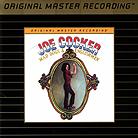January 1999
They also gave audiences a chance to actually see their heroes -- something that was rare in the days before MTV and music videos. Live concert recordings were popular for a great many rock fans because they offered an audio snapshot of the excitement of a concert that otherwise would not be seen. Now concerts are routinely made into videos and television specials. In 1970, the live recording was one of the only ways for listeners to share the immediacy and thrill of a concert. While rock was reaching one of its high-water marks in the first few years of the 1970s, rock and roll music had lost some of its creativity. The average British rock ensemble had become a guitar-driven quartet, and the repertoire was firmly rooted in the blues. Not surprisingly, this was the era of the great lead guitarists, and the luminaries of the day -- Eric Clapton, Jimmy Page, Jimi Hendrix, Jerry Garcia, Johnny Winter and Pete Townsend -- all toured with their own small bands playing concerts that often became lengthy jam sessions. Musical strides that tried to incorporate the blues, gospel, country, jazz and folk music into the American rock mainstream a few years earlier were being ignored by a great many bands. String and horn sections and backup singers, once common on rock recordings, were largely missing. The task of preparing the concert that would eventually become Joe Cocker’s Mad Dogs & Englishmen tour fell to guitarist and songwriter Leon Russell. Russell’s experience performing with several great American bands went far beyond the rock and blues Cocker ordinarily performed. That experience compelled him to add a horn section, extra percussion, keyboards and a choir of singers to the core band. In all there were 40 performers on stage -- a true spectacle of the time. In fact, these concerts were so unique that they were filmed and released as a documentary. To the contemporary listener, the recording of Mad Dogs & Englishmen can’t be considered anything but an under-rehearsed and hastily thrown-together show. Even when this recording was made, two months into the tour, there were glaring mistakes by the rhythm section, strange miscues by the horn section, and problems on stage with feedback. The attention span of the backup singers seems to ebb and flow, and the entrances of the band in several instances is tentative. Joe Cocker croaks out unintelligible lyrics and his banter with the audience belies the personality of one of his speaker cabinets. But on an emotional level, the concert was extraordinary. Riding the wave of success from his album Joe Cocker!, he presents a new version of the Boxtops hit "The Letter" -- his first US top-ten hit. Other new versions of previous successes, like Leon Russell’s "Delta Lady" and the Beatles’ "She Came In Through The Bathroom Window," appear in this concert as well. The last time I heard this album was on the rattly speakers of a portable hi-fi system. It sounded (by present standards) awful, but it didn’t really matter. The rawness of Joe Cocker’s vocals, the out-of-tune and tinny honky-tonk piano, and the distant horn section all came across. The emotion and the fun also made it through those horrible little speakers. And so the album became hugely successful -- Joe Cocker’s third gold album in less than two years. But it was a flawed success, and the blemishes of the original recording make it difficult to judge the level of improvement of this remastered release. Those of us who remember Joe Cocker’s wild gyrations and grimaces while he was performing will also remember that, due to his spasmodic body motions, he was almost always off-mike. No amount of remastering can remedy that. Posterity will also have to live with the unbalanced horn section and backup singers. Also impossible to correct is the enormous amount of crowd noise that was coming through the microphones during these recordings. Without the luxury of filters or noise gates on older recordings, the band is simply louder than the crowd, and that’s that. Remastering an imperfect recording onto CD is fraught with problems, the most considerable is how one uses all of the available technology to keep this recording from sounding better than it should. It is an achievement that this CD has replicated the sound of the original -- it sounds as good as its analog predecessor, and doesn’t have the glassy veneer of digital re-releases. It fills out the range of modern stereo speakers, but it doesn’t seem like a false or manufactured sound. In fact, this release does essentially what it should do -- re-create the original recording to sound as it did. Joe Cocker fans who are replacing their LP libraries will be happy with this CD. GO BACK TO: |
 Joe Cocker - Mad Dogs
& Englishmen (Remastered)
Joe Cocker - Mad Dogs
& Englishmen (Remastered)![[Reviewed on Gold CD]](../format/goldcd.gif) In
1970, rock and roll was becoming the common language of a young generation that was
starting to find its voice. It had matured from the innocence of the previous decade and
had entered the political arena. Concerts were awash in long hair, peace signs, and
protest banners. Rock concerts became rallies, and often rallies became concerts.
In
1970, rock and roll was becoming the common language of a young generation that was
starting to find its voice. It had matured from the innocence of the previous decade and
had entered the political arena. Concerts were awash in long hair, peace signs, and
protest banners. Rock concerts became rallies, and often rallies became concerts.